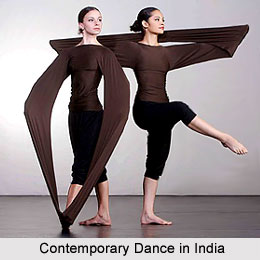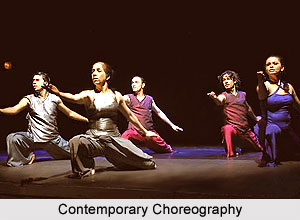 Contemporary dance in India has come a long way ever since the days of Pandit Uday Shankar. However, to have a full estimation of the concept of `postmodern` dance, it is mandatory to keep in mind the social infrastructure in which it develops. The 1960s sprouted the quizzicality`s of the historical `truths` and ideological doctrine that reign over the social, political and artistic chambers. Society unfurls a process of beginning to the identification of plurality, relativism of knowledge and subjectivism of perception. According to contemporary dance history, the ambience of socio- cultural influx is perceptible in arts by a penchant for experimentation and radicalism. As a result there has been a striking change in the context of education, training and performance of dance across the country in recent times.
Contemporary dance in India has come a long way ever since the days of Pandit Uday Shankar. However, to have a full estimation of the concept of `postmodern` dance, it is mandatory to keep in mind the social infrastructure in which it develops. The 1960s sprouted the quizzicality`s of the historical `truths` and ideological doctrine that reign over the social, political and artistic chambers. Society unfurls a process of beginning to the identification of plurality, relativism of knowledge and subjectivism of perception. According to contemporary dance history, the ambience of socio- cultural influx is perceptible in arts by a penchant for experimentation and radicalism. As a result there has been a striking change in the context of education, training and performance of dance across the country in recent times.
With changing times, and change in outlook towards Indian classical dance has made the contemporary art practices in India one of the enlightening aspect. The trajectories and chronologies of the development of dance in India itself are very different from those of other countries or cultures. Modern awareness in the dance actually emerged largely through inventions of new aesthetic through regular intervention of British. The 200 years of British rule in India actually led to reinterpretation and change in arts of India on a cataclysmic scale.
The education on art is no more decided on caste, religion, tribe, family or restricted to learning through a modern school or from a particular Guru or teacher. In the contemporary framework the engagement of artists are more restricted to institutional set ups. Students taking dancing lessons are often outside the structured organizational set ups. The students are also taking up lessons regarding diverse education that was practically not possible even few years ago. There are various forms of dance that are being practised in India. Experimenting with one`s own peers, learning from videos or through the internet, creating one`s own vocabulary and even making hybrid forms from very diverse and sometimes seemingly opposing ends of the spectrum, are all part of the dance activities in the country
 This activity of flexible working practices and training in the field of arts has actually resulted in democratization and even diversification of arts. Even a few years ago the term dance would mean folk, classical or cinematic form of dance. But in the contemporary scenario it conjures up a varied forms and styles performed in a variety of contexts. The free style of Bollywood dance approaches, the increasing role of dance on social occasions, both public and private, the huge popularity of dance related competitions in colleges, annuals meets in colleges and on reality TV, have all contributed to smudging of several "Art House" concepts of dance in India.
This activity of flexible working practices and training in the field of arts has actually resulted in democratization and even diversification of arts. Even a few years ago the term dance would mean folk, classical or cinematic form of dance. But in the contemporary scenario it conjures up a varied forms and styles performed in a variety of contexts. The free style of Bollywood dance approaches, the increasing role of dance on social occasions, both public and private, the huge popularity of dance related competitions in colleges, annuals meets in colleges and on reality TV, have all contributed to smudging of several "Art House" concepts of dance in India.
Styles, forms and categories are no longer rigid compartments in dance today. With awareness of dance promoted through classes that have sprung up to meet the demand, the audience for contemporary expressions in dance is also increasing steadily. One can sense a different kind of approach and interest in dance resulting in multiple avatars of the art form in varied contexts, creating what we know as contemporary dance.
For an artist in the contemporary period it is thus important to note that, nurturing creativity and openness to work with disciplines, forms, structures, styles and content, thus enhancing one`s own physical strengths flexibility and adaptability leading to a highly improved body awareness are needed in order to take up challenges posed by each project. It is needless to say that in order to achieve this, giant amounts of material, financial, human and time investments are needed.
It is indeed interesting to experience the dynamics of contemporary urban centers in India as they are beginning to produce fresh, new and individual voices in dance today. Today`s young artists are not disturbed by the dictates of tradition, regionalism or nationality. On the contrary, they look at the world as their framework and do not have much inhibition in working with people from other backgrounds. Dance is also leaving more conventional art house performance arenas and entering into new public, non-esoteric contexts such as pubs and malls.



















